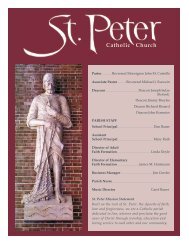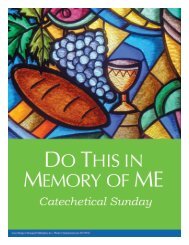St. Peter Catholic Church
St. Peter Catholic Church
St. Peter Catholic Church
You also want an ePaper? Increase the reach of your titles
YUMPU automatically turns print PDFs into web optimized ePapers that Google loves.
Twenty-seventh Sunday in Ordinary Time October 9, 2011<br />
Praying the Mass Anew…<br />
The New Translation of the Roman Missal<br />
The day will be Sunday, November 27th, 2011. This day will<br />
likely seem as any other Sunday. Faithful <strong>Catholic</strong>s will rise<br />
from sleep at their chosen times; each will carry out the normal<br />
Sunday morning preparations for Mass, arriving at the parish<br />
church at a fitting time. Some will enter a familiar pew, while<br />
others sit in a place that is new to them. Some will open the<br />
missalette or hymnal to preview the readings of this First<br />
Sunday of Advent; others may simply pray in silence before<br />
Mass. All will be as normal.<br />
Mass will begin with a typical music selection, fitting for this<br />
Advent morn. The priest and other ministers will process into<br />
church, going to their proper places. Finally, the priest will lead<br />
the people in the Sign of the Cross and greeting. All of a<br />
sudden, an entire parish congregation, on hearing the priest greet<br />
them with the words “The grace of our Lord Jesus Christ, and<br />
the love of God and the communion of the Holy Spirit be with<br />
you all,” will respond “And with your spirit.” No longer will<br />
the Sunday be merely routine; we will be praying the Mass<br />
anew. The people‟s response, perhaps seeming unfamiliar or<br />
odd at first, will begin the praying of the mass with words that<br />
will likely include new musical settings for newly worded<br />
hymns like “Holy, Holy, Holy Lord God of hosts,” and new<br />
responses to such phrases as “Behold the Lamb of God, behold<br />
him who takes away the sins of the world. Blessed are those<br />
called to the supper of the Lamb.” Everyone, aware of the<br />
change, will be ready to respond “Lord, I am not worthy that<br />
you should enter under my roof, but only say the word and my<br />
soul shall be healed.” Many will receive the Eucharist, aware<br />
that is the same gift of Christ‟s Body and Blood as on the<br />
previous Sunday, but with renewed understanding, as given<br />
through the words themselves, of who it is that they receive and<br />
how we are nourished in the offering of every Mass.<br />
The given scene, while it may be a replica of every experience<br />
to be had, serves as a means to begin answering the question<br />
“why?” Some may recall the first time they prayed the Mass in<br />
English. Others may have never known prayers for Mass other<br />
than in English versions that have been prayed over the last 40<br />
years. Some may be hesitant to accept what appears on the<br />
surface as nothing more than change “for change sake.” Yet, all<br />
deserve to know why such a change is happening, and why it is<br />
happening now.<br />
Translations Direct From the Latin…<br />
These new prayer settings, the fruits of new English translations<br />
of the venerable and time-honored Latin prayers for Mass, are<br />
given as a further implementing of the use of the common or<br />
“vernacular” languages in the liturgy of the <strong>Church</strong>. In the<br />
1960‟s, the Second Vatican Council sought to reform the liturgy<br />
of the <strong>Church</strong> so that all of the faithful would more easily and<br />
fruitfully be able to enter into liturgical prayer, actually<br />
participating in the saving mysteries of Christ with a greater<br />
sense of prayer and deeper awareness of God‟s presence in the<br />
rituals of the <strong>Church</strong>. An expression of this fruitful participation<br />
envisioned at Vatican II was through the fitting use of the<br />
common languages of peoples throughout the world. In addition<br />
to using Latin, such opportunity for the use of vernacular was<br />
set forth by the Council to aid the people in praying the Mass<br />
with more complete understanding. For the last 40 years,<br />
3<br />
English speaking countries have already prayed most, if not all of<br />
the Mass parts in their own language, using English versions<br />
translated from original Latin prayer texts. However, the work of<br />
translating necessarily continues from generation to generation, as<br />
language continues to evolve and change, and new words, with<br />
more definite meaning come to be.<br />
Currently, we have received a renewed and revised English<br />
translation of these Latin prayers. Within this new translation,<br />
specific goals and guidelines for translating prayers, as set forth<br />
by the <strong>Church</strong>, have been more fully accomplished. This new<br />
translation portrays in English the more literal meaning of the<br />
Latin prayers, restoring words that convey the truths of faith more<br />
properly, and reconnecting these texts more clearly to their<br />
biblical sources and roots. In some cases, too, it is a more formal<br />
or poetic style. While the learning of the new versions will take<br />
time and practice, this learning process invites us to open our<br />
minds and hearts to being renewed in the <strong>Catholic</strong> faith that we<br />
have received and truly love, encouraging us to grow in<br />
knowledge of the faith itself, deepening our love for God.<br />
In the weeks ahead, pages like this one will be in my column,<br />
both to explain the new versions of the prayers, and to give<br />
answers to real questions and concerns as we prepare to pray the<br />
Mass anew, beginning on that historic First Sunday of Advent,<br />
November 27th, 2011. Each insert will seek to invite all of us to<br />
go beyond simply knowing the new words to a deeper and more<br />
complete understanding of the great gift of the Holy Mass.<br />
As we begin this journey toward praying the Mass anew, may we<br />
commend ourselves to the care of the Blessed Virgin Mary,<br />
Mother of the Incarnate Word, who responded, “Let it be done to<br />
me according to your word,” that Jesus Christ, the Word made<br />
flesh, may lead us to love and understand the renewed words<br />
through which we approach the Father in heaven at every Mass.<br />
The Burning Question: Why is there a need for a new<br />
translation?<br />
Pope John Paul II issued the third edition of the Missale<br />
Romanum (the Latin text of the Roman Missal) during the Jubilee<br />
Year in 2000. This new edition included many new texts<br />
requiring translation. In addition, the experience of the years after<br />
the Second Vatican Council gave rise to a desire for more formal<br />
and literal translations of the original texts from the Vatican<br />
Council. Pope John Paul II, being a linguist, realized in his<br />
travels and celebrating Holy Mass around the world, that some<br />
language groups were not praying what the original Latin text<br />
said. We all were not praying the same thing. He penned a<br />
document entitled Liturgiam Authenticam where he expresses his<br />
desire for greater unity with our words, with what we say and<br />
pray within the Mass. He challenged each language group to<br />
conform their translations more in line with the original Latin.<br />
Latin, by the way, is still the official language of the Roman<br />
<strong>Catholic</strong> <strong>Church</strong>.<br />
This new translation will employ the best of what we have<br />
learned about translation and liturgical language in two<br />
generations of celebrating the Liturgy of the vernacular. It will<br />
provide an opportunity to reflect more deeply on what we say and<br />
pray and on the Eucharist itself.<br />
It is October folks…truly Missouri‟s best month! Enjoy its<br />
colors, its smells, its autumnal foods, and its incredible beauty.<br />
And…I‟ll see you in church!<br />
Monsignor Jack 1-3-5
















